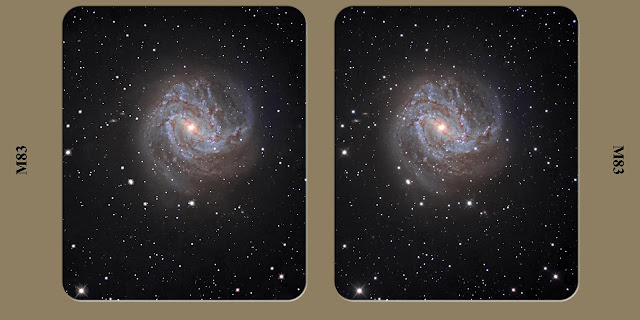COPYRIGHT, PLEASE NOTE
All the material on this website is copyrighted to J-P Metsavainio, if not otherwise stated. Any content on this website may not be reproduced without the author’s permission.
Have a visit in my portfolio
PORTFOLIO:https://astroanarchy.zenfolio.com/
Tuesday, June 1, 2010
M16, the "Eagle nebula" as a 3D stereo pair
Parallel vision
Cross vision
Other 3D-formats can be found here:
Original 2D-image:
NOTE! This is a personal vision about forms and shapes, based on some known facts and an artistic impression.
Viewing instructions can be found from a Right hand side menu.
HOW?
I have been asked many times, how my 3D-images are done, so here it goes!
Viewing instructions can be found from a Right hand side menu.
HOW?
I have been asked many times, how my 3D-images are done, so here it goes!
All the original 2D-images are imaged by me.
Due the huge distances, no real parallax can be imaged to form a volumetric information.
I have developed a method to turn any 2D-astronomical image to a various 3D-formats. The result is always approximation of the reality, based on some known facts and an artistic impression.
What are the known facts?
By using a scientifically estimated distance of the object, I can organize right amount of stars front and behind the object.
(as then we know the absolute position of an object at our Milky-way)
There usually is a known star cluster or a star(s) coursing the ionization and stars can be placed in right relative position to the nebula itself .
Stars are divided to groups by apparent brightness, that can be used as a draft distance indicator, brighter the closer.
The nebula itself is emitting its own light, when ionized, typical to each element.
The thickness of the nebula can be estimated by its brightness.
Many other relative distances can be figured out just carefully studying the image, like dark nebulae must be front of bright ones.
The local stellar wind, radiation pressure, from the star cluster shapes the nebulae, pillar like formations must then point to a cluster for that reason.
Same radiation pressure usually forms kind of cavitation hole at the nebulosa, around the star cluster, by blowing away all the gas around it.
Same radiation pressure usually forms kind of cavitation hole at the nebulosa, around the star cluster, by blowing away all the gas around it.
Many other small indicators can be found from the image itself.
The artistic part is then mixed to a scientific part, rest is very much like a sculpting.
I have published a, little simplified, step by step tutorial about turning astronomical images to a 3D-stereo pairs under a PhotoShop. It can be found from here as a PDF: astroanarchy.blogspot.com/2009/04/neaic.html
WHY?
Firstly, they are great fun to do. Secondly, because I can.
3D-experiments seems to increase a public interest to a subject, as you might have noticed.
Personally, I have studied my astronomical images much deeper, than ever without 3D-modeling.
The 3D-studies have really add a new dimension to my hobby as an astronomical photographer. (pun intended)
Labels:
research and development,
stereo images
M16, the "Eagle nebula" as an anaglyph Red/Cyan 3D
You'll need Red/Cyan Eyeglasses to be able to see this image right.
Note, if you have a Red and Blue filters, you can use them! Red goes to Left eye.
Other 3D-formats can be found here:
Original 2D-image:
NOTE! This is a personal vision about forms and shapes, based on some known facts and an artistic impression.
Labels:
anaglyph images and movies
M83, the "Southern Pinwheel" as a 3D stereo pair
Parallel vision
Cross vision
Other 3D-formats can be found here:
Original 2D-image:
NOTE! This is a personal vision about forms and shapes, based on some known facts and an artistic impression.
Viewing instructions can be found from a Right hand side menu.
Viewing instructions can be found from a Right hand side menu.
Labels:
stereo images
M83, the "Southern Pinwheel" as an anaglyph Red/Cyan 3D
You'll need Red/Cyan Eyeglasses to be able to see this image right. Note, if you have a Red and Blue filters, you can use them! Red goes to Left eye.
Other 3D-formats can be found here:
Original 2D-image:
NOTE! This is a personal vision about forms and shapes, based on some known facts and an artistic impression.
Labels:
anaglyph images and movies
Subscribe to:
Posts (Atom)














